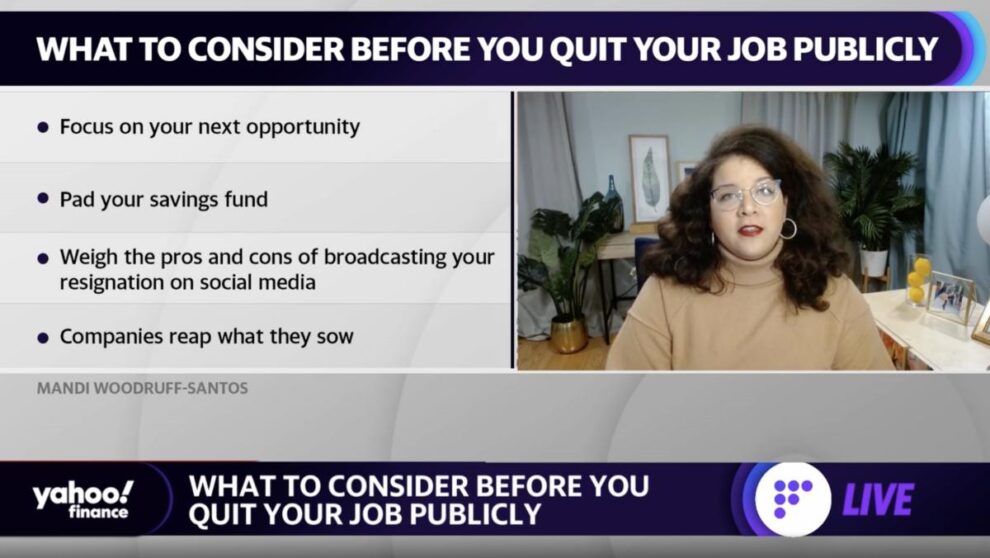
Yahoo Finance Contributor and Co-host of Brown Ambition Podcast Mandi Woodruff-Santos joins Yahoo Finance Live to discuss the increase of rage quitting amid the pandemic and what people should consider before doing it themselves.
Video Transcript
[MUSIC PLAYING]
– Welcome back to Yahoo Finance. Well, as a record number of Americans continue to quit their jobs, there is a growing trend that’s emerging. Rage-quitting is becoming quite the rage, and employees are taking walking out on the job viral.
But what’s the motivation behind it all? Here to help us discuss is Mandi Woodruff-Santos, Yahoo Finance contributor and co-host of “Brown Ambition Podcast.”
Mandi, thanks so much for being here. It’s so fascinating. There must be a lot of pent-up frustration for people to go to these extreme measures, right? And if I was a future employee for one of these applicants, I would think twice about hiring them. However, clearly they’re going to these extreme lengths because they want to be heard. What is the motivation behind all of it?
MANDI WOODRUFF-SANTOS: I think you’re seeing a perfect storm where not only are employers harder-worked, burned-out than ever, having just come through. We’re still in the middle of a pandemic, and you can’t forget these are human beings who have been through intense trauma these past couple of years.
But it’s also the fact that it’s never been easier for everyone to find a microphone and a platform and a stage to air these grievances. So whereas maybe, before, it was a strongly worded email, now it’s a TikTok viral video that’s got 8 million views. And it’s addicting to get that kind of feedback from your audience.
People are loving these rage-quitters. We’re loving supporting them. We’re loving seeing people stand up for themselves. It’s that David-and-Goliath, that storyline that continues to resonate with people.
I really encourage folks to be empathetic to people who are quitting. Clearly, they have been through some stuff if they are going to go to these great to assert themselves to their employer and say, you know what? I’m not going to stand for this, and I quit.
So I honestly would turn this from looking negatively upon the employees who are going out of their way to embarrass their employers and take a couple of steps back and ask ourselves, what’s going on with workers? Why aren’t they feeling respected, and how can we better train managers to handle employees?
– All right, Mandi. So let’s say I’m going through this in my head. I’m thinking about it. I’m gaining the courage to rage-quit or maybe just quit. But without making a spectacle of it, what should people be doing to prepare themselves before they quit, or at least quit publicly?
MANDI WOODRUFF-SANTOS: Absolutely. I would say if you’re getting to the point where you are enraged, and you’re at that breaking point where it’s gonna bubble over, and you may snap, take a step back and try to focus on yourself first. So I really encourage workers– don’t let it get that bad. Don’t become so disgruntled, so unhappy. There are actually steps that you can take to prevent that type of rage from bubbling over.
The first and most important point I’ll make is setting those boundaries at work in the first place. It has never been easier for people to Slack you, to Zoom you. We’re in touch with our employers, our colleagues all the time. And I think it’s even more crucial these days for people to draw a very firm line in the sand between where they’re willing to sacrifice their personal well-being for their work.
And it may sound uncomfortable, but I don’t think enough workers are doing this. They’re not setting clear boundaries. I will not be responding to emails after 6:00 PM Eastern Standard Time, thank you very much. Those are gonna go directly in my top of inbox for the morning.
Setting those clear boundaries is how you’re going to let people know where your limits are and let them know that you demand respect for your schedule and your time as well. And it may sound terrifying to a lot of workers out there, or they may find that they’ve tried to set those boundaries, and they have been dismissed. They have not been taken seriously.
I think if you have put your best foot forward, you’ve tried to set your boundaries, you’ve tried to give feedback to your manager on how you like to be managed, and the response is, oh, we don’t care about that, or, well, that’s not that’s not good for business, then I think it’s time for you to be coming up with your plan B. Where are you going to go next?
Forget trying to rub it in their faces that they’ve lost you. What’s your next career move, and where are you gonna go? And luckily, you’re in quite a good position, given the fact that employers have never been hiring the way they’ve been hiring lately, right?
– Yeah, absolutely.
You know what? All good advice there. And hopefully, employees don’t get to the point where they feel they need to do this, because if it’s on social media, it’s there forever, right? And it may come back to bite you. So “be careful” is, I guess, the best advice before you think about doing something like this.
Thank you so much, Mandi Woodruff-Santos, Yahoo Finance contributor and co-host of “Brown Ambition Podcast.”
We will take a quick break. And despite a tech hangover the last couple of sessions, many analysts are still bullish on Apple. Why so much love for the tech titan? Find out after a quick break.





